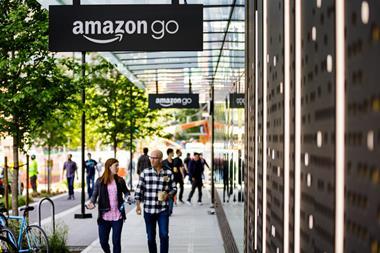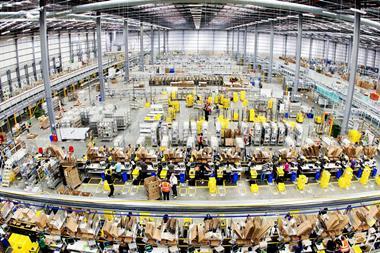Amazon didn’t plan its latest Christmas ad to be creepy, menacing and disturbing. But by swapping the Jacksons’ uplifting Can You Feel It with the sinister soundtrack from Captain America: A Winter Soldier, mischievous movie maker Omar Najam encapsulated the negative perception of Amazon as a retailer hell-bent on world domination.
The alternative ad, which Najam posted on Twitter, has been liked and retweeted tens of thousands of times. But Amazon will shrug it off, as it does with all the jibes it gets, about everything from the treatment of its warehouse workers to boss Jeff Bezos’s maniacal giggle. Then it will keep on selling phenomenal amounts of fast-moving consumer goods to consumers hooked on its fast-moving operations.
Besides, when it comes to its advertising, Amazon has nothing to worry about. According to research carried out for The Grocer by Phoenix MI, which measures the recall TV viewers have of an ad 24 hours after it airs, Amazon appeared in three of the top 10 fmcg ads aired on TV from November 2017 to November 2018 (and five of the top 20) including taking the number one spot for its 2017 Christmas ad. Oh, and with its original soundtrack, its latest Christmas ad is a belter.
Google: What search data can tell us about the impact of supermarket Christmas ads
“Amazon has found the perfect balance between tugging at our heartstrings and focusing on its products and services,” says Sarah Humphreys, retail lead at creative agency Isobel. “The singing boxes make great use of Amazon’s ‘smiley arrow’. Using the Amazon logo as a smile points to how important a strong visual identity it is, for packaging, mass-media marketing and every consumer touchpoint.”
It’s “great storytelling based on relatable human truths,” says Rebecca Sykes, CEO at Mofilm. “We can all relate to that feeling of excitement you get when you receive a parcel in the post and Amazon’s smiley parcel-filled Christmas ad is a celebration of this.”
Amazon is also outperforming conventional grocery and fmcg rivals because it “isn’t making high street retailer ads; it’s making Coke ads,” says Owen Dowling, head of strategy at creative advertising agency Leagas Delaney. “Its Christmas ads, like the ‘Give A Little Bit’ 2017 tested here and its sister ad for 2018, have jumped past high street retailers like John Lewis by tapping into the secret of Coca-Cola’s advertising.”
“The breadth and intelligence of its advertising across multiple channels is why it’s been winning hearts and minds”
That secret is to “trigger familiar feelings of anticipation. To top the charts, however, they needed the genius that comes from the branding device. The Amazon smile is now at the heart of the Christmas story. They’ve weaponised their iconography.”
Turning the smile on an Amazon parcel into a “singing vehicle of emotion also makes an asset of the more cumbersome aspects of Amazon’s slick operations,” says Ed Woodcock, director of narrative at Aesop Agency. “This integration of product and brand into the ad helps with recall, and might explain why their advertising is not just memorable, but effective.”
For all the love out there for the smiley logo, the “underlying message in the Amazon ads is the notion of simplicity and ease,” says Sykes. “In other words, Amazon’s product truth. We buy on Amazon because it allows us to purchase more or less anything within seconds of us realising we need it. In their Christmas campaign, Amazon could have used voiceovers, graphics or punchy calls to action to remind us of this, but instead it’s communicated through visual cues of Amazon lockers, deliveries to the office and people on their way home with a parcel under their arm.”
Amazon is also canny about exactly when it shows its ads to “ensure they are front of mind at crucial high-volume moments,” says Chris Gorney, director at marketing agency Journey Further and former head of media planning at Asda. “They do that by being clever with their media spend, not being ‘always on’, but deploying their media at very specific moments, creating a high level of frequency through-the-line, so the majority of the population are very aware of Amazon at that important moment.”
It’s also in a “luxurious position where it doesn’t need to flog its extensive catalogue of products,” says Pierce Calnan, strategist at creative Twelve Agency. “The breadth and intelligence of its advertising across multiple channels is why it’s been winning the hearts and minds of people, despite alleged poor warehouse working conditions and tax avoidance. Though if those remain unaddressed, the tides may turn.”
Click here to view the Top Campaigns of 2018 in association with Phoenix
Perhaps the negative publicity swirling around the way Amazon allegedly treats its warehouse staff, a situation that inspired Najam’s soundtrack switcheroo and prompted the GMB union to submit an FOI request to the ambulance service (it revealed 115 call-outs to Amazon’s warehouse in Rugeley, compared with just eight at a similar-sized nearby Tesco warehouse) has prompted it to show a more caring side.
“Social listening and customer studies carried out by Amazon demonstrated that it needed to show its human face, so in the last few years it has embarked on creating marketing materials that focus on human stories,” says Christophe Castagnera, head of connected experience at Imagination. “Emotional-led advertising is far more effective than ‘rational’ advertising.”
Yet he also points out the functional side of Amazon’s ads, which show off everything from the convenience of Alexa, to easy pick-ups from Amazon lockers, and its automated warehouses. And he says Amazon “ensures it includes a clear call to action in its communications, to encourage as much engagement with the brand to convert into action as possible.”
This strategy of combining “emotion-led content and experiences, powered by effective data, in terms of its content distribution and analytics, means they are combining creative intelligence with data in a way many brands could learn from.”
Consumers still engaged with TV
So what does this demonstrably effective approach say about the evolution of advertising in 2018? TV hasn’t been the only screen-based option for advertisers for a long time. Multichannel campaigns are the norm in 2018, hitting consumers from all angles, particularly on social media like Twitter, Instagram, Facebook, Snapchat and YouTube. Cheaper and vastly more targeted, they are often dubbed the future for advertising.
But Aaron Goldman, CMO at marketing technology company 4C Insights, says while marketers are “increasingly adopting multichannel strategies as consumers increasingly interact in multichannel ways, TV is a critical part of that approach because consumers continue to engage with TV content. Now they are just empowered to do it on the device and at the time of their choosing.”
“In the last few years Amazon has embarked on creating marketing materials which focus on human stories”
He also points out that a multichannel approach ultimately just gives a boost to the original TV-based content, saying it gives brands and retailers the ability to “extend their experience with TV content into the digital sphere, where branded content can achieve a multiplier effect and reach new audiences. These new behaviours are transforming the viewing experience and creating new opportunities for brands to reach consumers on TV, opportunities which are, in many ways, more powerful and impactful than they used to be.”
All the winning campaigns, including Amazon, took advantage of this multichannel environment to create a bespoke approach across different channels. Like Müller (3) which deployed the hashtag #Mullerlicious and offered behind-the-scenes clips of Nicole Scherzinger filming the ad on YouTube. Or McDonald’s (2), which used the hashtag #ReindeerReady and has dozens of YouTube videos that use influencers to enthuse about the quality and provenance of its food.
As well as the social stuff, Amazon is also a heavy investor in print media, says Ian Tansley, non-executive director at global digital marketing agency Croud. “Perhaps the most intriguing aspect of Amazon’s advertising strategy is just how much effort, energy and resource it invests in offline despite its online prowess. In many ways, its recent approach has been akin to that of an old-school advertising strategy.”
Still, online businesses like Amazon and Google “have been the biggest spenders on TV since 2016,” says Sykes. “Whilst there’s a certain irony to this, it’s not that surprising. With nearly half of TV audiences also using mobile devices at the same time, TV ad breaks are the perfect opportunity to prompt an online purchase, or even just look for more information. This points to a wider trend of marketers discovering TV and digital to be bedfellows rather than adversaries.”
The reality is that “almost everyone has a TV at home,” says Meli Tatar, research manager at Phoenix MI. “Yes, there is a rise in streaming and social media, but TV meets all the age demographics and can reach the broadest part of the population in the most effective and efficient way. The more modern you go, the more you will reach a younger audience, maybe. But TV remains the one medium that is most effective in reaching out to everyone.”
“TV meets all the age demographics and can reach the broadest part of the population in the most effective and efficient way”
And when it comes to fmcg “you want to reach as many people as possible, and all kinds of different people. You don’t necessarily want to segment. If you do, you can obviously target specific programmes, but TV is still the one medium where you can go as broad as possible and use other media channels to go out with specific messages for each demographic group.”
It’s why the idea that TV advertising is dying is “just not true,” says Stephen Fox, chairman of specialist advertising agency FKC. “TV in the home remains the most powerful medium for brands to promote their products and services. It is true there is a huge and ridiculous choice of fragmented other media to use, but that is gradually becoming mistrusted and complained about as it is so intrusive and unwanted. And it’s impossible to measure.”
There are a number of sophisticated ways to measure advertising impact across media outlets, though - social or otherwise - including econometrics, which strips out variables like price, promotion, currency and macro economics. But it will always be effective to simply ask TV viewers what they watched the day before and ask what ads, if any, they remember seeing.
That’s the methodology deployed by Phoenix MI, which compiled the Top Campaigns data for The Grocer. “It’s essentially memory recall after watching TV in a real world environment,” says Tatar. “The environment plays a big part because of all the distractions you have at home while watching TV. We send out requests for a survey 24 hours after the ad has aired, then identify whether they were watching the programme when the ad was shown. Then we ask specific questions to figure out whether they remember the ad, then about the content, what happened, then on to messaging.”
The research also reveals other major trends that illuminate the wider strategic approach taken by advertisers today.
Future standout
In the future, those that stand out will “find ways to drop the ego and put both their products and their brand second to the customer,” says Christina Stahlkopf, associate director at C Space. “As consumer mindset shifts towards experiences and personalised, meaningful connections with brands, superficially pushing products, discounts and offers at them is quickly met with cynicism and disinterest.”
Data and technology will also prove every bit as important as emotion and sensitivity, says Philip Slade, director of strategy at Jaywing. “We are only just touching the edge of what seamless customer experiences could be. Amazon has many experiments running in real-world retail and financial products to test these waters and the overwhelming sense is it’s driving the next stage of its journey.”
“An open-access channel could be a gold mine for data. Brands would know who their customers are, and past purchases”
He also points out how Amazon’s enthusiasm for on-demand video could make the retailer even more powerful than it already is. “Recent media coverage suggests Amazon could be launching a free-to-air video streaming service,” he says. “This would be massive for brands. Amazon Prime remains ad-free but an open-access channel could be a gold mine for consumer intention data. Not only would brands know who their customers are, as well as their past purchases, they could deduce their future behaviour following exposure to an advert.”
None of which will calm the fears of any rival retailers feeling the Amazon pinch. Tesco and Argos, arguably Amazon’s biggest UK rivals, first feature in the rankings at 35 and a dire 193 respectively.
But if anything demonstrates why Amazon will be loving everything about advertising at the moment, it’s the fact that for every dollar Amazon shells out for advertising around the world, it’s raking dollars back in by hosting them.
Buried in its recent trading update is a “nugget that supermarkets should keep a keen eye on - its ad operations,” says Mike Teasdale, planning director at Harvest Digital. “Amazon Advertising, while trailing the Facebook/Google duopoly by a country mile, has seen $1.3bn of growth in the space of 12 months. To put that in context, Twitter’s earnings were about $750m in the same quarter, so Amazon’s ad operations have witnessed nearly two Twitters of growth. Yet few have noticed. For retail CMOs, it should be a wake-up call to the changing nature of the Amazon ecosystem. These firms aren’t spending on Amazon Advertising out of love, but because some 55% of consumers turn to Amazon first when searching for products online.”
Worrying news, unless you are Jeff Bezos. But for any retailers or brands wondering how to catch up via their 2019 ad campaigns, they really need to focus on creating a “connection” with viewers, says Tatar.
“People need to relate. That’s the only way an ad can break through all the other noise we have out there. And if that is backed by consistency, media spend and time on air, they are the ads that will do well.”
Downloads
Top Campaigns
PDF, Size 46.35 kb



















No comments yet